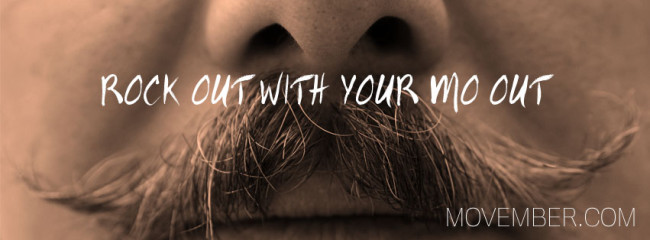Bryan Deluca loves it when people stop him on the street. He likes the inquisitive looks and puzzled faces. “As long as people are asking, I’m happy,” DeLuca says. What is it about him that makes him stand out in a crowd? Quite simply, it’s his “mo.”
In the last decade, the world, and the U.S. in particular, has seen an explosion of pink. The NFL, 5-hour Energy, and countless other corporate brands have broken out in the color in the name of women’s health and the fight against breast cancer. Although Breast Cancer Awareness Month is in October, it’s become chic to be seen in pink yearlong. With all the attention on women’s health, some might come to the conclusion that men’s health was unjustly left in the dust; after all, more men are predicted to develop prostate cancer in 2013 than women are breast cancer. This, however, is changing, and it all starts with facial hair.
A moustache, or “mo” as it is affectionately called in Australia, is where the revival of men’s health begins. In 2003, about 80 men in Adelaide, South Australia grew their moustaches out during the month of November in support of men’s health. They adapted the local vernacular of “mo” to give their cause a memorable name. As Movember gained more traction and men in Adelaide increasingly grew their facial hair out, the idea itself grew and moved outside of South Australia and eventually spread across the globe. In the late 2000s, Movember boomed in popularity across continental Europe and Canada, with millions of dollars being donated to prostate cancer foundations across the world. In 2007, Movember finally made its way to the U.S. and set up a headquarters in Los Angeles. Since then, Movember has slowly been growing in popularity as local chapters are formed.
How, exactly, does one raise money by simply growing a moustache? The idea works much like a race sponsorship. Men register at the beginning of Movember and get a homepage where they can post pictures of their moustaches and give updates. Friends, family, coworkers, and anyone else who wants to support the grower then donate money to the Movember Foundation, which supports the Prostate Cancer Foundation and Livestrong. Movember, much like Susan G. Komen in October, hosts happy hours, concerts, and various events throughout the month of November to raise awareness and funds.
The key to Movember is its local chapters. Local chapters, like Dallas Moustache, compete against chapters in other cities to see who can raise the most. As of Nov. 14, Dallas Moustache was in ninth place among all U.S. cities with $110,000 raised. Chapters encourage local corporations to compete, and DFW based Fossil, Pepsi Co., and Dr. Pepper all have teams. Bryan DeLuca and Riley Nail, who work together on the Dallas Moustache team, say that the local chapters are also the most important when it comes to awareness.
Local chapters are also a central way to get a key Movember demographic involved: women. According to Riley Nail, Director of Events and Marketing at Hotel Zaza and an active member of Dallas Moustache, women play just as important a role in Movember as men. “Mo’Sistas (female movember supporters) primarily get involved to help support the men they love and act as a ‘cheerleader’ in a way to push you through those ‘itchy’ and/or ‘awkward’ times when you think, ‘Alright, I have had enough of this mustache,'” Nail said. Mo’Sistas are also important when it comes to supporting healthy decisions, DeLuca adds. “Wives, sisters, and other female family members and friends are just as important as men,” he said. “They not only encourage moustache growth, but can also help by reminding the men in their lives to get checked and stay healthy.”
While Movember’s growth over the last half-decade has been outstanding, the awareness month has been hurt by confusion over what men should be celebrating. Ian Michalak, a University of Alabama at Birmingham junior who grew out his facial hair in November, provides a perfect example of this confusion. “I just kind of grew my facial hair out because I knew that a lot of other people were doing it,” he said. “I know that Movember is a thing, but everyone also talks about No Shave November,” Michalak added. Movember’s success, it seems, is being cannibalized by the other men’s health November event, No Shave November. While the difference between a beard and moustache may seem miniscule, it should be made clear that the two November based charities are separate entities. Although based on the same premise, the American Cancer Society runs No Shave November. DeLuca also adds that Movember, with its worldwide base, is much larger than No Shave November. “The confusion between the two only really happens in the U.S. Movember is the only facial hair event in most of the countries it is in,” he said.
Will Movember ever reach the heights achieved by Susan G. Komen and other breast cancer societies? Although Nail says that it will take time for men’s health issues to rise to the prominence of breast cancer, he has seen improvement in the three years he has participated in Movember. “In these three years I have definitely seen an impact and change with men being more open and willing to discuss issues, fears, concerns and even their past or current health status,” he said.
In the end, that’s the aim of Movember: to help men know the precautions that must take in order to stay healthy and ultimately cancer free. Until there is a cure for prostate cancer and other men’s health issues, Movember participants will continue to embody the official Movember motto to the best of their ability – “Rock Out with Your ‘Mo Out.”










